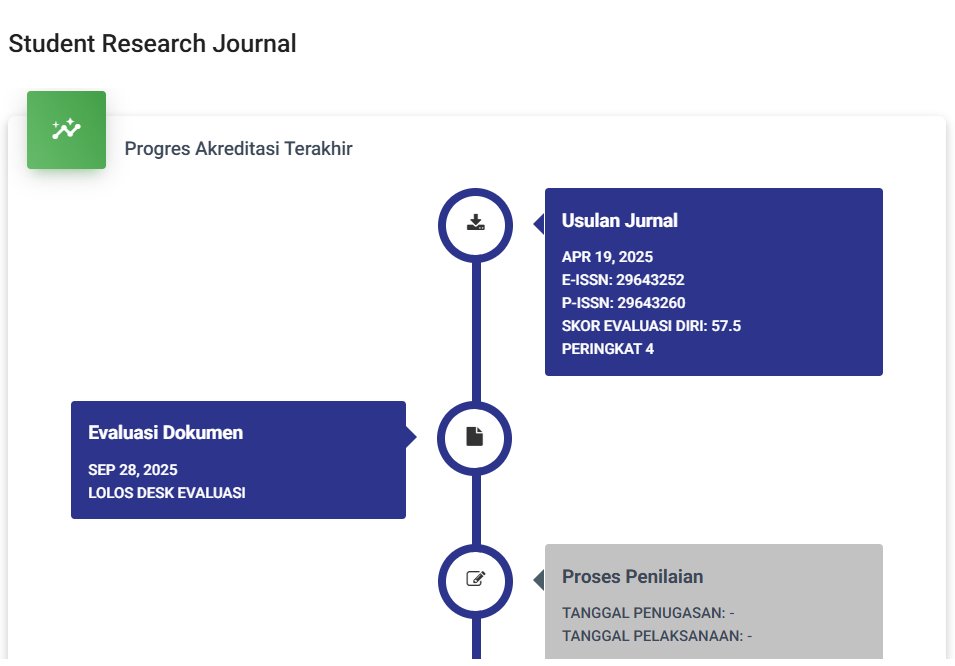Analisis Faktor Faktor Penentu Keberhasilan Atlet Jujitsu Gresik Kelas Newaza Dalam Pekan Olahraga Provinsi (PORPROV)
DOI:
https://doi.org/10.55606/srjyappi.v2i3.1345Keywords:
Athlete, Jujitsu, Physical, Motivation, Mental, PorprovAbstract
The sport of jujitsu has gained significant popularity among the fighting community and martial arts athletes, including Gresik athletes. Although jujitsu has been around for centuries, the sport has experienced rapid growth in recent years, often taking part in some of the most prestigious martial arts competitions, including the Provincial Sports Week (Porprov). In a broader context, this research can also contribute to existing literature on the factors that influence athlete performance in the Gresik jujitsu martial arts sport. This research is a type of quantitative research. The research design used is a qualitative cross-sectional which allows researchers to study and evaluate the characteristics of various research subjects at a certain poin in time, in this case the assessment was carried out at the PORPROV time. This research was conducted in various places related to the activities of Jujitsu athletes, including their training grounds and the Provincial Sports Week (PORPROV) competition locations. The population in this study was a Gresik Jujitsu athlete who competed in the women's Newaza system class category in the Provincial Sports Week (PORPROV). The population in this study was a Gresik Jujitsu athlete who competed in the women's Newaza system class category at the Provincial Sports Week. . The sample in this study included a number of Jujitsu Gresik athletes taken purposively, their coaches and other supporting parties. There are three research instruments used, namely; interviews, observations, and document searches. In analyzing qualitative data, this research will adopt the Miles and Huberman data analysis model which consists of three main stages: data reduction, data presentation, and drawing conclusions. From the results of the interview, internal factors show that the athlete has high motivation and is physically fit, but it is unfortunate that his mental state is not good, where during the interview the athlete felt nervous, inferior and countered in the final round. Not only that, external factors also include coaches who are very supportive and also feel the nervousness that athletes feel. From the results above, there are two factors determining the success of jujitsu athletes in Gresik district, namely internal factors and external factors. Internal factors include the athlete's self-motivation, mental and physical characteristics. Meanwhile, external factors can come from official support, parents, the environment, as well as facilities and infrastructure.
References
Abidin, A. K., Nurhidayat, N., & Fatoni, M. (2023). Tingkat kesiapan mental atlet Rugby 7’S Jawa Tengah dalam persiapan Porprov. Indonesian Journal of Sport Science and Technology (IJST), 2(2), 124–131. https://doi.org/10.31316/ijst.v2i2.5582
Agustina, C. A. (2017). Teori motivasi. In H. dan L. Andjarwati (Eds.), Teori Maslow.
Andjarwati, T. (2023). Motivasi dari sudut pandang teori hirarki kebutuhan Maslow, teori dua faktor Herzberg, teori Y McGregor, dan teori motivasi prestasi McClelland. Encyclopedia of Human Resource Management, Second Edition, 1(1), 167–168. https://doi.org/10.4337/9781800378841.h.4
Andreato, L. V., Lara, F. J. D., Andrade, A., & Branco, B. H. M. (2017). Physical and physiological profiles of Brazilian Jiu-Jitsu athletes: A systematic review. Sports Medicine - Open, 3(1). https://doi.org/10.1186/s40798-016-0069-5
Aulia, M. D., & Hakim, A. A. (2022). Analisis kesiapan mental pada atlet bola tangan Kota Surabaya menjelang Porprov Jawa Timur 2022. Journal Name, 1, 76–81.
Del Vecchio, F. B., Hirata, S. M., & Franchini, E. (2011). A review of time-motion analysis and combat development in mixed martial arts matches at regional level tournaments. Perceptual and Motor Skills, 112(2), 639–648. https://doi.org/10.2466/05.25.PMS.112.2.639-648
Effendi, H. (2016). Peranan psikologi olahraga dalam meningkatkan prestasi atlet. Nusantara (Jurnal Ilmu Pengetahuan Sosial), 1, 27.
Geen, R. G., & Brody, N. (1985). Human motivation. The American Journal of Psychology, 98(1), 158. https://doi.org/10.2307/1422777
Goliot, F. T. M. (2024). Pengaruh kompensasi dan motivasi terhadap peningkatan prestasi atlet binaan Komite Olahraga Nasional Indonesia (KONI) Kota Solok. Journal Name, 4(02).
Hilmi. (2016). Motivasi ditinjau dari teorinya. Journal Name, 4(August), 30–59.
Ilham, Z. (2021). Peranan psikologi olahraga terhadap atlet: The role of sport psychology in athletes. Prosiding Seminar Nasional Pendidikan Kepelatihan Olahraga, 1(2), 274–282.
Jannah, M., Permadani, F. D., & Widohardhono, R. (2022). Motivasi berprestasi olahraga pada atlet pelajar ketika pandemi Covid-19 di Jawa Timur. Paedagoria : Jurnal Kajian, Penelitian dan Pengembangan Kependidikan, 13(1), 60. https://doi.org/10.31764/paedagoria.v13i1.8082
Kuspriyani, D. S., & Setyawati, H. (2014). Survei motivasi prestasi atlet klub bulutungkis Pendowo Semarang tahun 2014. Journal of Physical Education Health and Sport, 1(2), 108–114.
Marjono, P. (2018). Teori motivasi dan pengaplikasiannya (pp. 5–28).
Prasnanto, D. D. (2018). Profil kondisi fisik atlet putra UKM Ju-Jitsu Unesa. Journal Name.
Prima, P., & Kartiko, D. C. (2021). Survei kondisi fisik atlet pada berbagai cabang olahraga. Jurnal Pendidikan Olahraga dan Kesehatan, 9(1), 161–170. https://ejournal.unesa.ac.id/index.php/jurnal-pendidikn-jasmani/issue/archive
Rahmawati, L. C., & Wisnu, H. (2020). Identifikasi faktor-faktor pendukung minat siswa terhadap ekstrakurikuler Jujitsu di SMK Kawung 2 dan SMA Negeri 11 Surabaya. Jurnal Pendidikan Olahraga dan Kesehatan, 307–310. https://ejournal.unesa.ac.id/index.php/jurnal-pendidikan-jasmani/article/view/35348
Risman, D., Damrah, D., Syahrastani, S., & Sasmitha, W. (2024). Faktor-faktor yang mempengaruhi prestasi olahraga panjat tebing dinilai dari sudut pandang pelatih dan atlet. Jurnal JPDO, 7(3), 22–29. https://doi.org/10.24036/jpdo.7.3.2024.53
Romansyah, W., & Ismalasari, R. (2018). Efektivitas teknik komite dan randori kelas B senior putra cabang olahraga Ju-Jitsu di kejuaraan Ju-Jitsu Universitas Muhammadiyah Ponorogo antar dojo ke-VII se-Indonesia 2018. Journal Name, 1–12.
Talahaturusun, J. C., Solissa, J., & Hukubun, M. D. (2023). Survei motivasi berprestasi atlet pada Club Petuanan Wailete Desa Hative Besar Kota Ambon. EDUKASIA: Jurnal Pendidikan dan Pembelajaran, 4(2), 2091–2100. https://doi.org/10.62775/edukasia.v4i2.552
Van Eerde, W., & Thierry, H. (1996). Vroom’s expectancy models and work-related criteria: A meta-analysis. Journal of Applied Psychology, 81(5), 575–586. https://doi.org/10.1037/0021-9010.81.5.575
Yulianto, M. R., & Kusnanik, N. W. (2021). Analisis faktor-faktor yang mempengaruhi pencapaian prestasi tim hockey indoorputra Kabupaten Gresik di Porprov 2019. 1–8.
Downloads
Published
How to Cite
Issue
Section
License
Copyright (c) 2024 Milkhatil Arofah, Achmad Widodo

This work is licensed under a Creative Commons Attribution-ShareAlike 4.0 International License.








